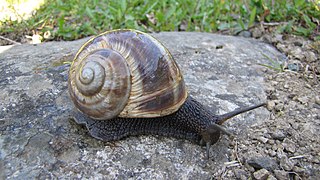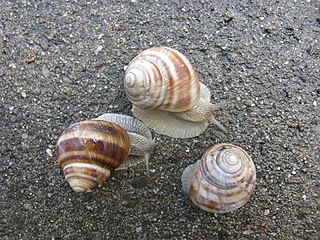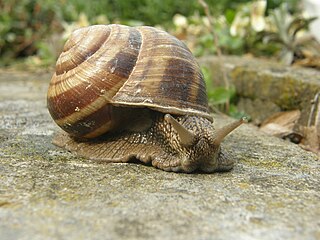
Helix is a genus of large, air-breathing land snails native to the western Palaearctic and characterized by a globular shell. It is the type genus of the family Helicidae, and one of the animal genera described by Carl Linnaeus. Members of the genus first appeared during the Miocene. Well-known species include Helix pomatia and Helix lucorum. Cornu aspersum, though externally similar and long classified as a member of Helix, is not closely related to Helix and belongs to a different tribe of Helicinae.

Helix pomatia, common names the Roman snail, Burgundy snail, or escargot, is a species of large, air-breathing stylommatophoran land snail native to Europe. It is characterized by a globular brown shell. It is an edible species. Helix pomatia commonly occurs synanthropically throughout its range.

Helicidae is a large, diverse family of western Palaearctic, medium to large-sized, air-breathing land snails, sometimes called the "typical snails." It includes some of the largest European land snails, several species are common in anthropogenic habitats, and some became invasive on other continents. A number of species in this family are valued as food items, including Cornu aspersum the brown or garden snail, and Helix pomatia. The biologies of these two species in particular have been thoroughly studied and documented.

Helix lucorum is a species of large, edible, air-breathing land snail, a terrestrial pulmonate gastropod mollusk in the family Helicidae, the typical snails.

Helix ceratina, the Corsican snail, is a species of air-breathing land snail, a terrestrial pulmonate gastropod mollusk in the family Helicidae, the typical snails.
Helix nucula is a species of air-breathing land snail, a terrestrial pulmonate gastropod mollusk in the family Helicidae, the typical snails. It has a rounded shell with white aperture margins; it differs from the similar Helix figulina by fine spiral grooves on the upper shell surface. Previously, the name H. nucula was used also for Helix pronuba, an unrelated species occurring in North Africa and on Crete, creating some confusion in the literature.

Caucasotachea is a genus of medium-sized air-breathing land snails, terrestrial pulmonate gastropod molluscs in the family Helicidae.

Levantina is a genus of air-breathing land snails, terrestrial pulmonate gastropod mollusks in the subfamily Helicinae of the family Helicidae, the typical snails.

Helix borealis is a species of large, air-breathing land snail native to Greece and the south-west of Anatolia. It is characterized by brown to dark brown margins of the shell aperture. For decades, the species has been considered synonymous with Helix cincta.
Helicinae is a subfamily of terrestrial gastropods in the family Helicidae. It contains mostly large land snail species, distributed in the western Palaearctic. The most recent classification proposed division into three tribes.

Helicini is a tribe of terrestrial gastropods in the family Helicidae. It contains mostly large land snail species, diversified in particular in the Balkans, Anatolia, and the Caucasus.

Helix vladika is a species of large, air-breathing land snail native to Montenegro and Serbia. It has a brown, conical shell. It is the largest land snail species in Europe. Typical habitat are beech forests. The species is closely related to Helix straminea.

Helix buchii is a species of large, air-breathing land snail native to northeastern Turkey, Georgia, and northern Armenia.

Helix dormitoris is a species of large, air-breathing land snail native to mountainous regions of Montenegro, eastern Bosnia and Herzegovina and western Serbia.
Helix pronuba is a species of large, air-breathing land snail in the subfamily Helicinae of the family Helicidae.
Maltzanella is a genus of terrestrial pulmonate gastropod mollusks in the family Helicidae, the typical snails. It has two known species distributed in Turkey. The shell is similar to Helix, which is the sister lineage to Maltzanella.
Lindholmia is a genus of large terrestrial pulmonate gastropod mollusks in the family Helicidae, the typical snails. It has two known species distributed in northwestern Turkey and southern Georgia. The shell is globular, with narrow dark bands.

Helix thessalica is a species of large, air-breathing land snail native to Europe. It is externally similar to Helix pomatia, but has a dark grey penis and vagina. The species has been long considered synonymous with H. pomatia.

Helix straminea is a species of large, air-breathing land snail native to North Macedonia, Albania and Italy.












